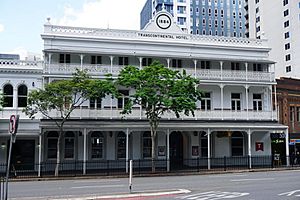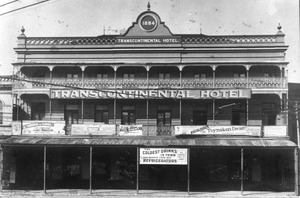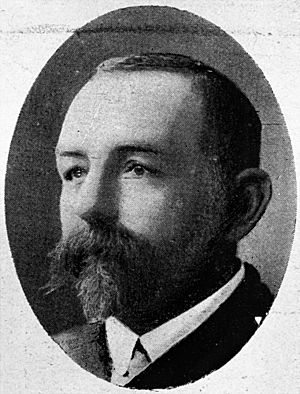Transcontinental Hotel facts for kids
Quick facts for kids Transcontinental Hotel |
|
|---|---|

Transcontinental Hotel from North-East, 2016
|
|
| Location | 462-468 George Street, Brisbane City, City of Brisbane, Queensland, Australia |
| Design period | 1870s - 1890s (late 19th century) |
| Built | 1883 - 1884 |
| Architect | Francis Drummond Greville Stanley |
| Official name: Transcontinental Hotel | |
| Type | state heritage (built) |
| Designated | 21 October 1992 |
| Reference no. | 600122 |
| Significant period | 1881-1884 (fabric) 1884-1935 (historical) |
| Lua error in Module:Location_map at line 420: attempt to index field 'wikibase' (a nil value). | |
The Transcontinental Hotel is a historic hotel located at 462-468 George Street in Brisbane City, Queensland, Australia. It was designed by a famous architect named Francis Drummond Greville Stanley and built between 1883 and 1884. This important building is listed on the Queensland Heritage Register, which means it's protected for its historical value.
Contents
The Hotel's Early Days
The Transcontinental Hotel was built from 1883 to 1884. In 1879, a businessman named Peter Murphy leased some land on George Street. He later bought the empty land next to it in 1881.
Planning a New Hotel
On August 28, 1883, Peter Murphy announced his plan to build a new hotel on this site. He was already a hotel manager and a successful businessman. He was also a member of the Queensland Legislative Council, which is like being part of the local government.
The new hotel was planned to welcome travelers arriving by train at the nearby railway station. It was designed to have many rooms for guests. These included 16 bedrooms, a dining room, a lunch room, a billiard room, and several sitting rooms. It also had bathrooms, a kitchen, and storage areas.
Design by a Famous Architect
On September 22, 1883, the well-known architect Francis Drummond Greville Stanley asked for bids to build this new hotel for Peter Murphy. The hotel was designed to be four storeys tall, with one floor below street level.
The Brisbane Courier newspaper reported that the Transcontinental Hotel had 27 bedrooms and seven public rooms. It also featured a billiard room and a private area for guests. The front of the hotel had a decorative sunshade. The two upper floors had balconies with fancy iron columns and railings. The hotel aimed to offer comfortable stays and excellent food.
George Street's Grand Hotels
In the 1880s, George Street was home to many of Brisbane's best hotels. The Transcontinental Hotel was one of them. Other famous hotels included the Bellevue Hotel and the Treasury Hotel. Today, only a few of these grand old hotels, like the Transcontinental, the Treasury, and the Grosvenor, are still standing.
Changes Over Time
In 1906, a new manager named Denis O'Connor took over the hotel. He hired architect George Henry Male Addison to make big changes to the inside of the hotel. When the new area opened on October 30, 1906, people said the Transcontinental was "the most ornate and best equipped" hotel in Australia.
The hotel was updated again in 1925. This was part of Peter Murphy's plan to make upper George Street a busy business area. By 1926, his plan had worked, and upper George Street became one of the most successful business areas outside of Queen Street and Fortitude Valley.
The Murphy family owned the Transcontinental Hotel until 1935. It was then sold to another company. The McCoy family managed the hotel for many years, from the 1930s to the 1980s. In 1988, the hotel's owners decided to restore the building. They put back the decorative iron railings that had been removed in 1965. They also repainted the outside in its original colors.
What the Hotel Looks Like
This hotel is from the Victorian era and is located near where George Street and Roma Street meet. It has beautiful, detailed ironwork on its balconies, which was recently put back.
The building is made of brick and has a smooth, rendered finish. It has three main storeys visible from George Street and a fourth level that is a basement. The basement walls are made of strong Brisbane Tuff stone.
Exterior Features
On the George Street side, there is a curved roof over the footpath, supported by posts. There are also balconies on the top two levels. Eight pairs of French doors open onto these balconies on each floor. The first-floor balcony is taller than the top-floor balcony. The very top balcony has a curved roof that is sloped at the ends.
The top of the building has a decorative wall called a parapet. This parapet has the words "TRANSCONTINENTAL HOTEL" in raised letters. There is also a curved section in the middle with the date 1884 inside a circle.
Even though the outside of the building has been restored, the inside has been changed a lot. Many original features were removed to create a large open space. This means the inside doesn't feel like a Victorian hotel anymore. However, its great location and the well-preserved outside details make it a very noticeable building in Brisbane.
Why the Hotel is Important
The Transcontinental Hotel was added to the Queensland Heritage Register on October 21, 1992. This means it is recognized for several important reasons.
Showing Queensland's History
The hotel was built close to the Roma Street railway station. It shows how important hotels were in the late 1800s for providing places for travelers to stay in Queensland. It also helps us remember that George Street used to be a very important area for hotels back then.
A Great Example of Its Kind
The Transcontinental is a good example of a hotel built in the 1880s, a time when Brisbane was growing fast. It shows off the detailed ironwork and the covered walkway over the street that were common features of hotels from that period.
Beautiful to Look At
The hotel is also important because of its beauty. It stands out and adds to the look of the street where George and Roma Streets meet.
Connected to Important People
The Transcontinental Hotel has a special connection to Peter Murphy. He was a member of the local government, a hotel manager, and a businessman who bought and sold property on George Street. He was involved with the hotel from 1881 until 1925.
Images for kids




